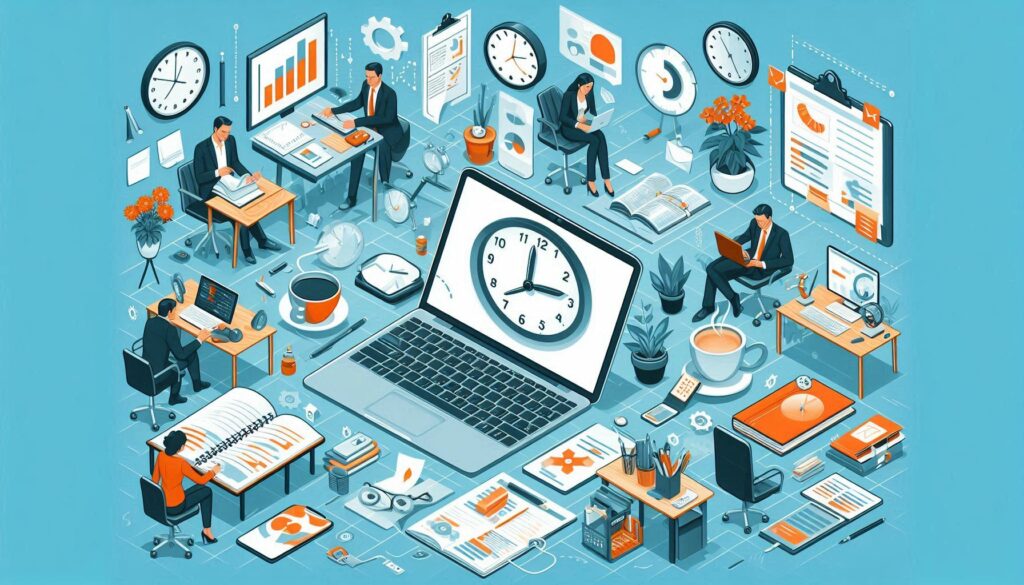10 Quick Work Routine Ideas That Boost Productivity

Key Highlights
- By setting up good work habits, you can really get more done.
- With their tasks sorted and a well-organized space to work in, successful people know how to keep things running smoothly.
- Starting your day with some mindfulness exercises and getting the tough stuff out of the way early can make a big difference in how much you achieve.
- In the afternoon, sticking to themed blocks of time for different tasks and taking breaks that are planned out can help keep your energy up.
- Taking a moment at the end of the day to think about what you’ve accomplished and making a list for tomorrow sets you up for even greater productivity.
Introduction
In our busy lives, it’s super important to be productive at work if we want to succeed. But let’s face it, with all the distractions and things demanding our attention, keeping focused and hitting our targets can be tough. That’s where having a good work routine comes into play. By setting up solid routines for work, we can make better use of our time, get more done efficiently, and ramp up productivity for high achievers.
All the successful folks out there in different fields have something in common – they’ve got these routines that keep them on track. These habits help them figure out what needs to get done first, manage their time well, and reach their goals. In this blog post,
we’re going to look at 10 quick ideas for creating a work routine that could really turn your productivity around. We’ll cover everything from getting your workspace organized to kicking off your day with some mindfulness exercises.
By looking into how successful people boost their productivity through various strategies like these, we’ll also touch on why wrapping up your day by reflecting on what you’ve achieved and planning tomorrow’s tasks is key.
On top of that, with tools and methods aimed at cutting down distractions and making great use of techniques like Pomodoro for managing time effectively, you’ll see just how adding these ideas into your daily life can lead to big improvements in how much you get done.
So let’s jump right in and find out about those simple but powerful ways to change up how you work for the better.
10 Effective Work Routine Ideas to Amplify Your Productivity
To really get the most out of your day, setting up good work habits is key. Here are 10 simple ideas for routines at work that can make a big difference in how much you get done.

- With starting your day with a clear plan, productivity often sees an uptick.
- By organizing your workspace, finding what you need becomes quicker and easier.
- Taking short breaks throughout the day helps keep energy levels high.
- Setting specific goals gives something concrete to aim for each day.
- Prioritizing tasks ensures the most important ones get attention first.
- Limiting distractions allows for better focus on tasks at hand.
- Using tools or apps designed to boost efficiency can save time and effort.
- Checking emails only at set times reduces constant interruptions.
- Ending the day by reviewing accomplishments sets a positive tone for tomorrow.
- Planning meetings wisely avoids unnecessary disruptions in workflow.
1. Organize Your Workspace for Efficiency
To boost your productivity, start with tidying up where you work. When things are messy and all over the place, it’s easy to get sidetracked and hard to concentrate on what you need to do. By setting aside some time to clear out the clutter and arrange your space neatly, you’re shaping an area that helps you work better and keeps distractions at bay. Make it a habit to clean up your desk for a few minutes daily, making sure everything goes back in its spot. This small step can help cut down the time spent looking for stuff so that more of your attention stays on getting tasks done without unnecessary interruptions. Additionally, it’s important to also clean up your digital workspace, such as your computer and files. This will not only help with productivity but also prevent distractions when you’re trying to relax and watch Netflix in the evening.
2. Prioritize Tasks Using the Eisenhower Box
Putting tasks in order of importance is key to getting things done well. The Eisenhower Box is a handy tool for doing just that, sorting your work into four groups: stuff that’s both important and needs to be done right away, things that matter but can wait, jobs that are urgent but not so crucial, and then the bits and pieces that aren’t pressing or all that important.

With this method, you start by jotting down everything you’ve got on your plate. Then you sort it out based on how critical each task is and how soon it needs attention. This approach helps clear up which tasks should get your immediate focus because they’re both significant and time-sensitive while showing what can either be handed off to someone else or dropped altogether. By zeroing in on the most vital tasks first—the ones at the crossroads of being super important and needing quick action—you make sure you’re putting your effort where it’ll have the biggest impact on keeping productive and achieving your big-picture goals.
Maximizing Morning Momentum
The way you start your morning can really shape how the rest of the day goes. If you kick things off well, it’s easier to keep that energy up and get a lot done. Here are a couple of ideas for work routines that could help you take full advantage of that early boost and become a morning person.
- With the right beginning, your productivity can soar for the rest of the day.
- To capture that morning momentum, consider these two strategies for an effective routine.
3. Start Your Day with a Mindfulness Exercise
Kicking off your day with a bit of mindfulness can really make the rest of it better. Here’s how you can add some simple exercises to your morning routine:

- With deep breathing: By spending a few minutes just focusing on taking slow, deep breaths in through your nose and out through your mouth, you’ll find yourself more relaxed and focused.
- By practicing gratitude: Each morning, jot down three things that make you feel thankful. Doing this helps turn your thoughts towards the positive side of life.
- Through visualization: Imagine nailing all the big tasks you’ve got lined up for today. It sets a good vibe for what’s ahead.
These steps are easy ways to get into a happier mindset as you dive into the day ahead.
4. Tackle the Most Challenging Task First
Mark Twain once said something pretty interesting: “Eat a live frog first thing in the morning, and nothing worse will happen to you the rest of the day.” What he meant was that we should get our toughest job out of the way right after we wake up. When you do this, not only do you feel really good about getting it done, but that feeling also helps keep you going all day long. If you put off these hard tasks, they just end up zapping your mental energy and making it harder for you to get stuff done later on. So by adopting this “eat the frog” approach and tackling your biggest challenge as soon as your day starts, can make everything else seem easier for the rest of your time awake. Don’t fall into the trap of procrastination – confront the things you’ve been putting off and break the cycle of anxiety and avoidance.
Enhancing Afternoon Productivity
A lot of us hit a low point in the afternoon, finding it hard to keep up with our tasks. But by tweaking how we do things at work, staying productive all day long is totally possible. Here are a couple of tips on changing your work routine that could really help you get more done after lunch, including waking up a few extra hours earlier in the morning and taking a nap during the afternoon.

- With some smart planning around your daily tasks, keeping energy high throughout the day isn’t just wishful thinking.
- By incorporating these strategies into your schedule, you might find yourself powering through those sluggish afternoon hours with ease.
5. Implement Themed Work Blocks
By setting up themed work blocks, you can keep your focus sharp and stay productive in the afternoon. When you group similar tasks together and give each group its own time slot, it stops you from having to jump back and forth between different kinds of work. This way, your concentration stays high, making you more efficient. For instance, one block could be just for handling emails while another might be set aside for creative projects or team meetings. Using this approach makes sure that at any given time, your energy levels are used wisely by focusing on just one type of task without interruptions.
6. Take Structured Breaks to Recharge
To keep up your productivity and avoid feeling totally wiped out, it’s really important to take breaks on purpose throughout the day. Studies have found that stepping away from work regularly can actually make you more focused, creative, and happy overall. Instead of trying to power through for hours non-stop, try taking a quick break every hour or so. During these times off, do something that helps bring back your mental energy like going for a walk, doing some mindfulness exercises or just chatting with someone at work for a bit. By fitting these planned pauses into your daily schedule, you’ll find yourself able to jump back into tasks feeling refreshed and ready to tackle them with new energy and the best work.
Setting the Stage for Tomorrow
Getting ready for the next day is super important if you want to keep being productive and have a smooth beginning. When you set things up for tomorrow, it helps lower your stress levels and lets you start off on the right foot. Here are a couple of ideas about work routines that could help with preparing for what’s coming next.
7. Reflect and Journal on Today’s Accomplishments
At the close of every workday, it’s a good idea to spend a little time thinking about what you’ve managed to do. Writing down your daily achievements in a journal can really help you see how far you’ve come and give your confidence a lift. On top of that, showing gratitude for these accomplishments and practicing self-compassion can create positive vibes and prepare you for an even better day ahead. By jotting down three things that made you thankful and three successes from the day, this habit helps shift your attention away from pending tasks towards appreciating what’s already been done.
8. Prepare Your To-Do List for the Next Day

Before you call it a day, make sure to jot down what you need to do for the next day. This way, when the next morning rolls around, you’ll have a solid plan and know just what needs tackling first. List your tasks by how important they are and think about using an app like Todoist to keep everything straight in your head. By sorting out your tasks before bed, you can avoid feeling overwhelmed in the morning and dive into work with sharp focus and speed.
Tools and Techniques for Productivity
In addition to implementing effective work routines, there are various tools and techniques that can further enhance your productivity. Here are some valuable tools and techniques to consider incorporating into your work routine:
| Column Name A | Column Name B |
| Technology | Embrace technology tools and apps that can help you stay organized, automate tasks, and minimize distractions. |
| Minimize Distractions | Identify and eliminate or minimize distractions that can derail your productivity, such as social media or excessive notifications. |
| Pomodoro Technique | Utilize the Pomodoro Technique, which involves working in focused bursts of time followed by short breaks. This can help improve time management and focus. |
| Time Management | Implement effective time management strategies, such as setting deadlines, prioritizing tasks, and scheduling dedicated work blocks. |
By leveraging these tools and techniques, you can optimize your work routine and maximize your productivity.
9. Use Technology to Minimize Distractions
Think about using tech tools such as browser extensions to keep social media at bay, apps that help you watch how much time you spend on your screen, or productivity boosters like Asana for better managing your tasks. With AI-powered apps, you can automate the boring stuff or set up email filters to keep your inbox tidy. Try out the Pomodoro Technique with some dedicated apps or templates too. By smartly using technology, you’ll be able to sharpen your focus, cut down on interruptions and get more done—truly beating distractions in today’s digital world. Make technology work for you as a helpful partner in making yourself more productive.
10. Adopt the Pomodoro Technique for Time Management

Try using the Pomodoro technique to manage your time better. With this method, you work in chunks, usually for 25 minutes at a stretch, and then take quick breaks. Studies have found that working like this helps keep your focus sharp and boosts how much you get done by matching how our brains naturally work best. By splitting up your day into these smaller parts, it’s easier to stay energized and not feel overwhelmed or burned out. Adding this strategy to how you do things every day can make it simpler for you to finish what you need while making sure there’s time set aside for short rests so that both your mind and body can recharge—leading to being more productive in less time all through the day.
Conclusion
By adding these simple ideas to your work routine, you’ll see a big jump in how much you get done. With everything in its place and knowing what needs to be tackled first, things just run smoother. Taking time each day to think about what went well helps too. Kicking off the morning with purpose and breaking up your tasks into specific themes keeps the energy going strong. And don’t forget about taking breaks on purpose or trying out something like the Pomodoro Technique to keep your mind sharp throughout the day. At night, looking back at what you achieved and getting ready for the next day means you’re always one step ahead. Stick with these habits regularly, and watch as they make a real difference in how productive you can be.
Frequently Asked Questions
How Can I Start Implementing These Work Routine Ideas?
To get going with these work routine tips, here’s a straightforward checklist you can use:
- Tidy up both your physical and online work areas.
- At the end of each day, go over what tasks you’ve finished.
- Face those tasks you’ve been putting off and break them into smaller parts.
- Plan out your to-do list for tomorrow.
- Prepare yourself to deal with the most important task first thing in the morning.
- Decide when your workday will end and make sure to stick with that time.
- -With gratitude or by doing something nice for someone else, wrap up your workday on a positive note.
By sticking to these steps regularly, just like successful people do, you’ll find it easier to enhance and build upon your daily working habits.
What Are the Benefits of a Structured Work Routine?
Having a set schedule for work can really help you out in many ways. For starters, it’s great for your mental health and overall happiness. You’ll find yourself getting more done faster and with better focus. With everything planned out, managing your time becomes easier, leading to less stress and worry. Plus, it helps keep a good balance between work and the rest of your life. By figuring out a routine that fits you best, all these advantages can lead to doing better in your job.
How to Stay Motivated When Your Routine Becomes Monotonous?
After a while, doing the same things every day can get boring and make you feel less eager to keep going. This drop in drive and mental energy is pretty common, but there are ways to shake things up:

- By mixing new stuff or challenges into your daily schedule now and then.
- Taking breaks or treating yourself as part of your regular activities helps stay on track.
- Paying attention to the moment and being thankful can help you see the good parts of your routine.
- Kicking off with a morning routine that gets you pumped for what’s ahead.
It’s important to remember motivation isn’t always just there waiting for us. It’s more like a muscle we have to work out regularly by finding what keeps us moving forward.
Can These Routines Be Adapted for Remote Work?
Absolutely, you can tweak these work habits for working from home. When it comes to remote work, sticking to a plan and being organized is even more crucial. It’s all about making sure there are strict limits in place, setting up a special area just for work, and keeping in touch with your team members properly. With these adjustments made for the at-home setup, boosting how much you get done and staying on the same page with your team members becomes easier.
How Often Should I Review and Adjust My Routine?
To make sure your routine is doing its job, it’s a smart idea to check on it and tweak things here and there. About every few months or so, or when you notice it’s not really helping much anymore, take some time to see how things are going. Look out for any shifts in how productive you are or how good you feel, and change stuff based on that. Try out various methods until you discover the one that suits you best.
What Tools Can Help Me Better Manage My Time?
In today’s world, a bunch of apps and tools are out there to help you keep your time in check and everything organized. You’ve got project management tools such as Asana or Trello that can really make things smoother for you. Then, there are time-tracking apps like Toggl or RescueTime which are great at keeping an eye on how much time you’re spending on tasks. And let’s not forget about task management apps like Todoist or Any.do; they’re perfect for making sure all your tasks and deadlines don’t get lost in the shuffle. With these kinds of tools by your side, organizing your workflow, tracking how far along you are with projects, and staying ahead of deadlines becomes a whole lot easier.
Are There Any Negative Effects of a Too Rigid Routine?
Having a set schedule for work can be good, but if it’s too strict, it might not be great for your mental health or how flexible you are. It’s key to strike the right balance between having a plan and being able to change things up when needed. By letting yourself mix in some unexpected activities or changes, you won’t feel so boxed in or stressed out by sticking strictly to a routine.
Tips for Balancing Flexibility Within a Routine
To find the perfect mix of sticking to a plan and being able to change things up, you might want to try:
- Blocking out time for surprises or last-minute stuff.
- Adding some extra time between your tasks so there’s room to move things around if needed.
- Getting good at being in the moment and rolling with the punches when changes come.
- Checking on how your schedule is working for you now and then, tweaking it as necessary.
By getting this balance just right, you can make a schedule that helps you get stuff done but also lets you adapt when life throws curveballs.






